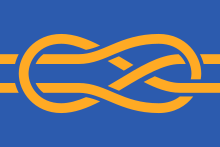Vexillology
Vexillology (/ˌvɛksɪˈlɒlədʒi/ veh-ksih-LO-luh-jee) is the study of the history, symbolism and usage of flags or, by extension, any interest in flags in general.[1] The word is a synthesis of the Latin word vexillum (which refers to a kind of square flag which was carried by Roman cavalry)[2] and the Greek suffix -logia ("study").[3] The first known usage of the word vexillology was in 1959.[4]
A person who studies flags is a vexillologist, one who designs flags is a vexillographer, and the art of designing flags is called vexillography. One who is a hobbyist or general admirer of flags is a vexillophile.
History
This section needs expansion. You can help by adding to it. (March 2018) |
The study of flags, or vexillology, was formalized by the U.S. scholar and student of flags Whitney Smith in 1961 with the publication of The Flag Bulletin.[5] During his lifetime, Smith organized various flag organizations and meetings including the first International Congress of Vexillology (ICV), the North American Vexillological Association, and the International Federation of Vexillological Associations (FIAV).[6] Smith, who is acknowledged as conceiving the term "vexillology" in 1957, wrote "[w]hile the use of flags goes back to the earliest days of human civilization, the study of that usage in a serious fashion is so recent that the term for it did not appear in print until 1959."[7] Before this time, study of flags was generally considered a part of heraldry, the study of armorial bearings.[8]
Involvement in vexillology includes academic work in fields such as sociology, history or design, professional or otherwise, contributions from the flag industry, and interest from those simply passionate about flags. ICV and local vexillological meetings often cover a wide range of interest in flags. Since 1969, an International Congress of Vexillology meeting has been organized every two years under the auspices of FIAV; papers presented at an ICV are published afterwards as the Congress's Proceedings.[5]
In more modern times, involvement in vexillology has become less popular but is more accessible due to many internet forums and communities, one of the most notable examples being r/vexillology,[9] a community on Reddit dedicated to the subject, which has popularised vexillology to younger generations. The constant reiteration of the flag as a symbol of a something that exists by the entity that it symbolises confirms the validity of the flag as an officially sanctioned and/or definitive symbol of an entity; therefore, there has been a close association between vexillology/vexillogic imagination in creating visual symbols that appear to legitimise micronational claims.[10][11]
Vexillological organizations
Vexillological organizations consist of the International Federation of Vexillological Associations (FIAV) which is considered an International Body of Vexilology. FIAV has more regional Associates and other Centers of Flags, such as North American Vexillological Association (NAVA),[12] Deutsche Gesellschaft für Flaggenkunde[13][12] (translated to English as 'German Society for Flag Studies'), Flag Heritage Foundation (FHF),[14][12] The Flag Research Center (FRC),[15][12] Flags of the World (FOTW)[12] and, 46 other affiliated associations and institutes with the International Federation of Vexillological Associations.
See also
- Glossary of vexillology
- Vexillological symbol
- Vexilloid
- Flags of the World
- List of flags by design
- List of national flags by design
References
- ^ Smith, Whitney. Flags Through the Ages and Across the World New York: McGraw-Hill, 1975. Print.
- ^ "Vexillum". www.merriam-webster.com. Merriam-Webster Dictionary. Retrieved 15 September 2020.
- ^ "About Vexillology". The Flag Institute. Retrieved 2018-06-01.
- ^ "Vexillology". www.merriam-webster.com. Merriam-Webster Dictionary. Retrieved 15 September 2020.
- ^ a b "Consider Vexillology". semioticon.com – SemiotiX. Retrieved 2018-04-01.
- ^ Vulliamy, Elsa (December 15, 2015). "Which flag is it? Take our quiz to find out". Archived from the original on 2022-08-17. Retrieved March 13, 2016.
- ^ "Vexillology". www.crwflags.com. Retrieved 2017-11-03.
- ^ Fox-Davies, Arthur Charles (1909). A Complete Guide to Heraldry. London, Edinburgh, T.C. & E.C. Jack. p. 1. ISBN 9781602390010. OCLC 913797670.
- ^ "r/vexillology on reddit.com". r/vexillology.
- ^ Bicudo de Castro, Vincent; Hayward, Philip. "The metamorphosis of Madeira's Ilhéu do Diego into Forte de São José, and the short-lived Principado do Ilhéu da Pontinha" (PDF). Transformations (35): 40–51.
- ^ Hayward, Philip (2019). "Under the Mermaid Flag: Achzivland and the performance of micronationality on ancestral Palestinian land". Coolabah (27): 72–89. doi:10.1344/co20192772-89. S2CID 216463609.
- ^ a b c d e "Current Members". Asociación Argentina de Vexilología. Retrieved 2021-12-02.
- ^ "Deutsche Gesellschaft für Flaggenkunde e.V. (DGF)". Flaggenkunde.de. Retrieved 2022-04-29.
- ^ "Flag Heritage Foundation". www.flagheritagefoundation.org.
- ^ "The Flag Research Center – The authority on flags, since 1962". Flagresearchcenter.org. Retrieved 2022-04-29.
Further reading
- Leepson, Marc. Flag: An American Biography. New York: Thomas Dunne Books, 2005.ISBN 0312323093
- Marshall, Tim. A Flag Worth Dying For: The Power and Politics of Flag. 2016.ISBN 1501168347
External links
 Media related to Vexillology at Wikimedia Commons
Media related to Vexillology at Wikimedia Commons- International Federation of Vexillological Associations


